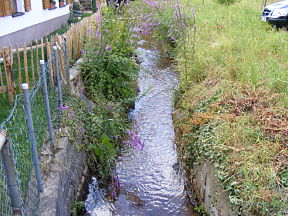- Mußbach
-
Mußbach 
The Mußbach on the southeastern outskirts of Gimmeldingen; on the left the north wall of Wiedemann MillOrigin Hoher Stoppelkopf 49°22′49″N 8°7′26″E / 49.38028°N 8.12389°ECoordinates: 49°22′49″N 8°7′26″E / 49.38028°N 8.12389°E Mouth Confluence with Rehbach in Neustadt an der Weinstraße
49°21′33″N 8°10′59″E / 49.35917°N 8.18306°EProgression Rehbach → Rhine → North Sea Basin countries Germany Location Palatinate forest Length 11.86 km (7.37 mi) Source elevation 460 m (1,510 ft) Mouth elevation 124 m (407 ft) Basin area 15.238 km2 (5.883 sq mi) River system Rhine The Mußbach is a nearly 12 mile long stream in the eastern Palatinate Forest and in the Anterior Palatinate (in the south of Rhineland-Palatinate). The former village of Mußbach (annexed by Neustadt an der Weinstrasse in 1969) was named after it.
Contents
Course
The two springs of the Mußbach rise a few hundred meters apart on the northeastern slope of the Hoher Stoppelkopf (567 meters) in the forest district of Wachenheim an der Weinstrasse. The confluence comes after about 2 km. The stream, which usually carries very little water, enters the Silbertal ("Silver Valley") in the forest district of Deidesheim. After 6 km it reaches the Neustadt suburb of Gimmeldingen in the Benjental Valley. Here, it receives an unnamed right tributary. The tributary is only 2 km logn, but carries much more water. Its origin are the Loosenbrunnen springs on the north flank of the 533 meter high Weinbiet on the eastern edge of the Palatinate Forest. Between 1952 and 1988, water from the spring was pumped up and used as drinking water in the local bar Weinbiethaus.
The combined stream feeds a small reservoir serving tourism in the Gimmeldingen Valley and then reaches the vines landscape flanking the German Wine Route. Here, it flows through the Neustadt suburbs of Gimmeldigen en Mußbach. The confluence with the Rehbach, the northern distributary of the Speyerbach, is about 2 km southeast of this residential area.
History
Name
In Middle High German, the stream, and the village named after it, were called Muosbach, meaning someting like swampy creek, because natural streams meander and cause a high groundwater level.
Mills
In the Middle Ages, the water of the creek was used to drive twelve mills. Their locations are now connected by the Mühlenwanderweg ("Mills hiking trail).[1][2] Among these are, ordered from spring to mouth:
- The Upper Mill in Deidesheim, so named because it had the highest position among the mills on the Mußbach.
- The building that is now Forsthaus Benjental was once a weapons forge, which used a water wheel to drive the iron hammer.
- The Lower Mill was built in 1718 in the extreme northwest of Gimmeldingen. It was ruined in a major fire in 1886.
- The Platsche Mill was built in 1821 and decommissioned in 1900. Only a millstone remains.
- The TalMuhle ("Valley Mill") was best preserved and was converted into a restaurant.
- As early as the Franconian times, a mill existed on the boundary of the former village of Lobloch (annexed by neighbouring Gimmeldingen in 1751), south of the Nicholas Church in Gimmeldingen. Historians believe that the mill once formed the nucleus of the village.
- The Wiedemann Mill at the border between Gimmeldingen and Mußbach remained in operation until the early 20th century and was then transformed into a winery. The former mill wheel was last seen in the 1960s.
Ecology
In the 19th and first half of the 20th century, the stream was used as an open sewer uses. It is now partially restored, but also partially canalized.
References and sources
- Eric Metz, Alfred Sitzmann (2008), Die ehemaligen Mahlmühlen am Mußbach, Gimmeldingen – Leben im Weindorf, Reinhard Kermann, Alfred Sitzmann
- This page is a translation of its German equivalent.
Footnotes
- ^ autor=Stadt Neustadt/Weinstr. Mühlenwanderweg (in German)
- ^ Eselsweg, Stabenberg und Mandelblüte (in German)
Categories:- Rhine basin
- Rivers of Europe
- Rivers of Rhineland-Palatinate
Wikimedia Foundation. 2010.
